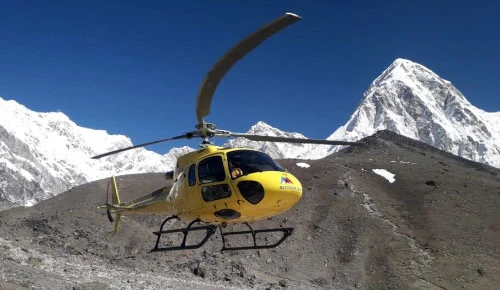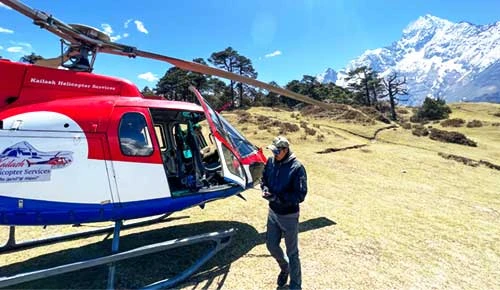How Long Does It Take to Reach Mount Everest?
Mount Everest (8848.86 m) has always been on the bucket list of many climbers. This peak is 8848.86 m above sea level. And this highest peak is considered the toughest for all the climbers.
To reach the summit of Everest, you will need a lot of physical strength and mental stability. Also, you will need to plan and arrange it months before the expedition.
Nepal names Mount Everest "Sagarmatha," and Tibet names it "Chomolungma." It is situated between China, Tibet, and Nepal in the majestic Himalayas. People from all around the world have been drawn to this summit for years.
Sir Edmund Hillary and Tenzing Norgay made the first successful climb to the top of the mountain in 1953. This story still motivates a lot of people today.
When planning a trip to Mount Everest, you should know how long it takes because there are other things to do besides climbing. Months are spent getting ready, getting used to the altitude, and travel.
These details help you to get mentally and physically ready for the adventure. It also help with planning time and other resources. Not only that, it also helps to create achievable goals where there is appropriate time provided for training, getting permits, and scheduling journeys.
In the sections to below, this blog will provide a breakdown of the different phases of Summit. Before it began up to actual target site tackling Mount Everest as a way to reveal the actual time one needs for climbing it.

Table of Contents
How many days does it take to reach the summit of Mount Everest?
It takes an average of 64 days to climb Mount Everest. Also, an ascent to this mountainous giant is no walk in the park. The thin air at such elevations decreases oxygen concentrations in the atmosphere and makes it difficult to breathe.
If anyone is planning on making their way up there anytime soon. Then he/she needs to know that some climbing gear will be necessary along the way like prusiks for fixing oneself onto fixed lines; ice-axes for breaking hard sections of snow or ice coverings. As well as six-toothed pointed metal pieces strapped around boots called crampons that provide secure footing on slippery surfaces.

The Everest Base Camp is located near the bottom of the icefall, 5300 meters above sea level. Before you go up to the Khumbu Icefall, you should stay there for four or five days to get used to the high altitude. Once you've climbed the Khumbu Icefall, you'll go back to Base Camp to rest.
First, you'll climb up to the first Base Camp and spend two nights there. You will get back to the main Base Camp in the end. Before going back to the main Base Camp, you should climb to the second Base Camp and spend the night there.
It gives you a set amount of time to get used to the altitude. That way of going up makes the climb faster than the others. This process of climbing and resting goes on for a week. Before the climb to the top in the final stage.
The North Ridge route is a technically difficult because of the rocky part. Our trip has been planned so that the time between activities is longer and more important than any other time. If you want to save energy, it's better to stop at different camps than to walk down all day.
Stages of Climbing Mount Everest
The task of climbing Mt. Everest takes 64 days. There are many difficulties and victories at every stage of this project until one reaches the peak of the highest mountain on Earth. We shall discuss extensively each phase; beginning with an ordinary camp found at its foot and finishing at the topmost point up there in the heavens.
First Stage: Reach Everest Base Camp (5,364 metre)
The first stage of the Everest Expedition is reaching base camp. That means the initial stage of the journey is Everest base camp trekking.

We will start our journey with a scenic flight to Lukla from Kathmandu. Then we will continue, trekking through various towns in the Everest region and reaching our base camp.
The first phase lasts for 14 days, from Kathmandu to base camp. These days offer you a stunning view of nature, mountains, a vibrant town, and local people and their daily lives.
Second Stage: Climbing to Khumbu Icefall (5400 to 6100 m)
The second phase of the expedition is to ascend Khumbu Icefall from the base campsite. This part is the most dangerous of the climbs.
We will start the climb after getting used to the altitude at the base camp. The Icefall is a moving glacier with huge ice seracs and deep cracks in the ice.

Ropes and ladders will be used to help us go through this section. You have to be careful as you move through this difficult stage to escape falling ice and crevasses.
Third Stage: Ascend to Camp I (Valley of Silence)
In the third phase, you have to get to Camp I, which is between 6100m (20,013 ft) and 6400m (21,000 ft) above sea level. The base is on a flat area known as the Valley of Silence.
The land is flat and snow-covered, causing multiple crevasses to form unexpectedly due to the rock mountain cliffs surrounding the trail. Remember that small cracks can quickly become ones that can kill you.

It is best to use fixed ropes to help you walk along the path. The trip to the first camp takes four to seven hours.
It is a great spot for us to relax and get used to the climate. From there, one can hike across crevasses that are several kilometers wide from the base up until we reach the icefalls.
Fourth Stage: Ascend to Camp II
Our fourth phase is to ascend towards Camp II. This camp is situated at 6800 meters. It is a little more protected and serves as an intermediary base camp.
This camp has more facilities compared to higher camp. It can be used as a point from which to climb higher for more acclimatization ascents.
We depart Camp 2 after a few days on the mountain, which served as a base camp from which to climb higher and acclimate before returning.
This camp is also the last camping site where you will get properly prepared food. At this high level, heading towards Lhotse's face all day could help you get used to the altitude.
Fifth Stage: Camp 3 Lhotse Wall (7100 m)
In the fifth step, you climb up to Camp 3, which is 7100 meters above sea level on the Lhotse Wall. The slope of this wall is icy and steep, so it needs ropes that are attached at certain places for safety reasons.
This climb is hard on the body and takes hikers to high elevations. At Camp 3, climbers stop for a short time to rest before beginning their ascent.
Even if the trail is flat, you have to keep clipping on the ropes and switching out the carabiners. For less experienced climbers, the walk from Camp 2 to Lhotse Wall can take 5 to 8 hours. For more experienced climbers, it only takes 4 to 6 hours.
Sixth Stage: Camp 4 Death Zone (8000 m)
The sixth phase is ascending to Camp 4, reached at 8000 meters (26,247 feet). This camp is also known as Death Zone for climbers.
This is due to the fact that the altitude is too high for human body to acclimate, while long exposure may result into death. Campers don't stay long in this zone

They stay just need to sleep before making their last attack on the mountain peak. The atmosphere has too little oxygen and it’s at this point that climbers use supplementary oxygen normally.
At the very end of the Lhotse wall, this is the last place to camp. It looks a lot like the peak at the edge of the world.
Seventh Stage: Mount Everest Summit
The seventh is the final stage of our Everest Expedition. In this phase, we will summit the Mount Everest, which is 8848.86 meters high. This is normally done in the dark, with the goal of completing it in the morning the next day.
After that, the hiker has to make their way through the South Col, Hillary Step, and the summit ridge. However, they must descend quickly after reaching the summit to prevent serious mountain sickness.
Climbers descend the same route from Camp 4 to the lower camps before arriving at the base camp.
Conclusion
Climbing to the summit can be quite tough but with proper preparation and arrangements, it can be achieved. If you are planning to reach the top of Mount Everest, you must be physically and mentally strong. So, plan andarrange your expedition and start your journey to legendary Everest,








